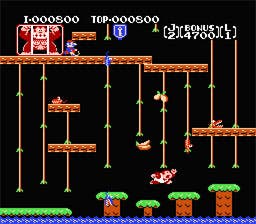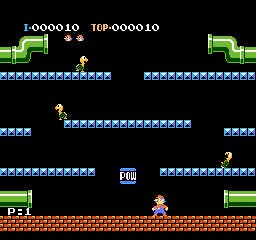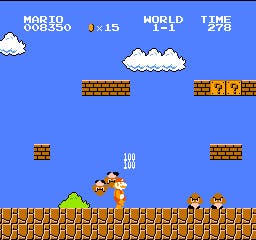Virtual Console: NES
14 titles available - but which ones are worth downloading?
Kicking off a series of regular updates on the Virtual Console releases, we thought we'd check out what the NES channel has to offer, and see whether these old 'Famicom' relics offer anything more than blind nostalgia appeal to a few veteran gamers out there.
Released way back on 15th July 1983 in Japan (1985 in the US and 1986 in Europe) it was an unquestionably decent piece of technology, equipped with a 1.79Mhz CPU, five channel sound and hardware sprite capabilities that allowed Nintendo to launch the machine with near perfect ports of some of its key arcade titles of the early 1980s, including Donkey Kong, its follow-up Donkey Kong Jr. and the original Mario Bros.
At the time, the idea of having such brilliant arcade replicas in the comfort of your own home was a huge selling point. The CBS Colecovision console almost managed it when it emerged in 1982, but the NES was an even more capable system - and from one of the arcade giants of the time.
But its true legacy was forged with original titles specifically designed for the home, such as all-time classics like Super Mario Bros. (September 1985), The Legend of Zelda (February 1986), Dragon Warrior/Quest (May 1986), Metroid (August 1986), Castlevania (September 1986), Final Fantasy (December 1987) and all the subsequent sequels that followed.
And yet for all that, from a European perspective, the NES really wasn't a big deal at the time. With Nintendo choosing to hand distribution over to a third party (Toy specialist Mattel in the UK & Ireland), and the release arriving some three years after its Japanese debut.
Hamstrung by high game prices and a somewhat limited promotion, it enjoyed relatively minor success compared with the dominant Spectrum/BBC/Commodore/Amstrad/Atari home computer scene. Usually relegated to a small section of only the larger specialist games retailers, NES titles were not only released much later than in the rest of world, but had to compete with well-established systems with a huge range of titles available two or three times cheaper than Nintendo's.
Besides, consoles hadn't really been on the European scene to any great degree since the demise of the Atari VCS, and the Eurogamers of the era were simply more comfortable with their clunky tape and disk-based systems and the quirky home-grown games that were available. With that in mind, many of the NES games released via the Wii's Virtual Console channel may be unfamiliar to even hardened veteran gamers that grew up in the '80s. Or even if you are familiar with their names, you might not have ever been in a position to play them.
As we all know, most of the successful brands on the NES have endured to this day, so their re-release on Nintendo's download service might be a bit of a voyage of discovery for many rather than the nostalgia trip it's presumably designed to be. Either way, you get to check out the genesis of classic games for a fraction of what they would have cost twenty or so years ago.
Note: None of the NES games available on Virtual Console require the Classic Controller, though all are compatible with it, as well as the GameCube joypad. All NES games cost 500 points.
Donkey Kong

Back in the days when Mario was simply known as Jumpman, he starred in Shigeru Miyamoto's classic early platform game and granted Nintendo a massive - and deserved - arcade hit across the world. The run, jump and climb premise was simple, fiendish and endlessly addictive, and unlike so many games of its era, this is still hugely enjoyable.
Annoyingly, Nintendo stripped out the excellent second level out of this surprisingly faithful 1983 port, making this a somewhat less than essential purchase - even for hardcore fans. In fact, Donkey Kong is one of several games you'll come across on the Virtual Console service that will make you wish Nintendo had included a Virtual Arcade alongside the console offerings so that we could play it as nature intended. Make enough noise and we can make it happen.
Retro rating: Three stars (out of five)
Donkey Kong Jr.

Despite the huge popularity of Donkey Kong in the arcades, the 1982 follow-up couldn't match its runaway success (in fact, I never once saw it in an arcade) despite being another well-crafted slice of platforming genius. This time, the tables have turned and 'Mario' has Kong held in captivity, prompting DK's son, Junior, to negotiate all manner of trap-laden locations to try and free his pa. While not necessarily as instantly engaging as the original, Miyamoto's design genius shines through to this day. Again, the 1983 NES port was arguably the best home version ever released, but there's no substitute for the arcade original. As with Donkey Kong, the vertical orientation of the screen has been squashed into 4.3 - and if you're playing on a 16.9 screen Nintendo makes no attempt to even maintain that aspect ratio, resulting in a wildly stretched out image. This rather slapdash approach to presenting the old classics in this unsympathetic way contrasts badly compared to Microsoft's approach.
Retro rating: Three stars
Mario Bros.

The first Nintendo game to ever feature Mario's name, but one that gave few clues to how much of a household name that he would become. Similar in essence to the multi-tiered platforming of Joust, this 1983 arcade game made a swift and near-perfect transition to the NES/Famicom when it was released in Japan in September 1983 and is still an enjoyable example of simple platform gaming from the era. Having apparently downed his carpentry tools and taken up work as a plumber, you must guide Mario around a static screen and get rid of all the pesky creatures (some which evidently inspired the Koopa Troopers of later Mario games) that keep coming out of the pipes. Again, the NES port doesn't quite include all the gameplay elements of the arcade, and visually isn't quite as good, but it's a good solid game that's worth checking out if you've somehow missed out on it (despite being included as an extra on numerous Mario titles down the years).
Retro rating: Three stars
Super Mario Bros.

Given that this is officially the best selling videogame of all time, it's quite likely you have this one, but it's also the one truly essential NES game to feature on Virtual Console. Released way back in September 1985, this awesome Miyamoto platforming masterpiece showed not only how far gaming had come in a short space of time, but it helped establish the console for the rest of the decade and beyond.
Finally embracing the possibilities of a scrolling play field, Super Mario Bros. was not only huge in comparison to Nintendo's previous platform titles (featuring an astonishing eight worlds, each comprised of four levels - despite being packed into a 40KB cartridge), but much more playable, faster and noticeably more forgiving in many respects. Even two decades down the line, it's incredible just how easy it is to get into, and how much its influences still linger on. And thanks to the fact that it was specifically designed for the NES, we have absolutely no moans about it. Apart from Nintendo not bothering to maintain the screen's aspect ratio when you're running in widescreen, this is, pretty much, Super Mario Bros as nature intended, with no borders in evidence. Some, though, claim the version delivered to European customers has been sped up to make up for the dreaded '50Hz effect'. Definitive answers on a postcard, etc.
Retro rating: Five stars
The Legend of Zelda

Another hugely important NES title for obvious reasons, and one that still has enough compelling elements to make it worth investigating 20 years on. Developed by Miyamoto and his team at the same time as Super Mario Bros, it went in a totally different direction, encouraging exploration and favouring a non-linear structure that gave players the kind of freedom that was rare at the time. Able to explore the overworld in whichever direction you fancied, the overarching goal is to complete nine dungeons on the way to finding the eight pieces of the Triforce of Wisdom.
Somewhat limited by memory restraints, the narrative element is distinctly lacking in this first Zelda outing, but the cryptic clues nevertheless lend it an enigmatic quality that makes it challenging and addictive - even now. Meanwhile, the gradual upgrade system, quest structure and combat still feels close enough to the Zeldas we know now to make it enjoyable. Needless to say, the visuals are beyond simplistic by today's standards, and the 'combat' is hilariously basic at first, so it might take a fair while to get into this as a newcomer. But for the sake of 500 measly points it's well worth having stored on your Wii if you're a slave to Zelda. For the rest of you, maybe best wait for Link to the Past to get a VC release...
Retro rating: Four stars.








